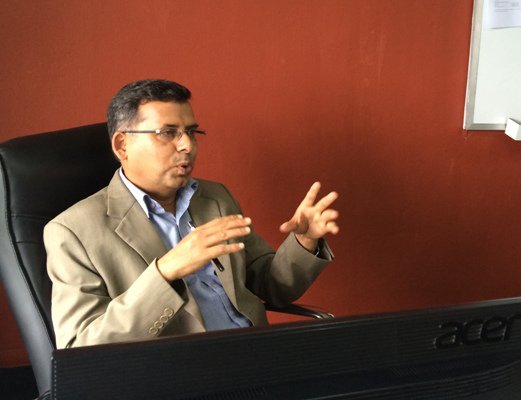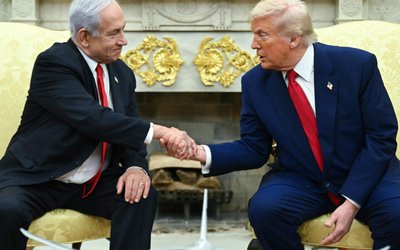
What exactly is the One Belt One Road (hereafter 'OBOR') initiative? What is Nepal's role in this initiative?
Fundamentally, the One Belt One Road (OBOR) initiative is a Chinese dream that envisions the revival of the historic Silk Road that gave a basis to Chinese prosperity based on international trade and political relations. It is now being reinvented with a plan to develop the land-based Silk Road Economic Belt that links up China with the rest of Central Asia, Europe, the Middle East and Russia and East Asia according to the modern parameters. The Belt includes more than 60 countries which were once situated on the original Silk Road. Nepal is connected to the Silk Road through the Tibet region of China. The other South Asian countries are also linked. In the OBOR concept, Nepal may serve as a gateway into the rest of South Asia.
What is the main focus of the initiative? Why is it considered important?
I think the main focus is on trade, investment and political relations. The objective is to improve the connectivity between the concerned countries by promoting investments in areas like policy, infrastructure, trade, currency and people. It is especially significant because this connectivity linked prospering China, one of the biggest and still-growing economies in the world, to Europe through Central Asia and Russia, the Persian Gulf through Central Asia and South East Asia, South Asia and the Indian Ocean. The Chinese also have the Maritime Silk Road concept that complements the Silk Road Economic Belt.
Moreover, in the Chinese neighborhood of developing and impoverished economies, the initiative stresses a win-win prospect for everyone. Although the initiative will no doubt boost China's growth by exporting its capital, technology and capacity globally, it will additionally make it possible for the countries on the Belt to invite investments, develop their own infrastructure and exchange comparative advantages.
Is Tibet a hindrance for Nepal to develop connectivity with the mainland China and, for that matter, the western provinces and the other countries in the central Asia?
I think the economic landscape of Tibet Autonomous Region is changing fast. Over the past few years, Tibet has seen a surge in investment in transportation, modern infrastructures, mining and metal processing, hydropower, wind power and solar power, beverage production (bottled water), and economic network. For example, an extension of Qinghai-Tibet railway line is a significant development. The upsurge of the tourism industry in Tibet is no secret. Rural infrastructures are being extended even to the interior parts of the region. The railway from Lhasa has already been extended to Shigatse, the closest largest city of Tibet from Kathmandu. It is being led to Kerung at the Nepal-China border. Therefore, rather than being a hindrance, Tibet will serve as a valuable gateway for Nepal to connect to China, its western provinces and then the countries in central Asia.
What opportunities are there for Nepal in that case?
Opportunities are plentiful, as long as we can adequately assess our needs and requirement and support the operation of the OBOR infrastructures and investments. With this our growth potential will increase in all core areas of our economy, including hydropower development, mining, agriculture and tourism. Once Nepal and China begin capitalizing on resources the Himalayas have to offer, there will be immense changes in the development landscape. The number of people travelling for leisure or business to Nepal will increase. And of course, as the gateway to South Asia for China and others in the Belt, Nepal will also be the safest and closest transit route for India and the rest of the region. With careful planning, Nepal can also establish itself as a regional financial and trading hub, further seizing additional growth opportunities.
They look very theoretical though!
I do not dispute your proposition. However, these kinds of initiatives start at a conceptual level anywhere. Activities start with trust. Building trusts begin with small things and shared values. After all we have to accept that infrastructure, investment and trade are mutually inclusive. One can see that the OBOR is already being implemented, which is the reason why it is gradually winning the faith of many countries.
How do you see the MOU signed between Nepal and China during Prime Minister K. P. Oli's recent visit to China?
The MOU most definitely brings in different milestones in Nepal and China's future relations. Nepal is set to use China's sea port facility, and Road and Railway connectivity is already being worked on. As a result, it will receive investments for new infrastructures. Trade will flourish and shipment costs will be drastically reduced. Nepal has already started conducting a feasibility study to extend the Qinghai-Lhasa-Shigatse Railway line to Kathmandu via Rasuwagadhi. A bilateral free trade agreement is the next order. Ultimately, through China, Nepal will be able to create relations with all the countries on the border of China which were historically inaccessible for it. Energy sector collaboration is being emphasized, and Nepal and China are also to strengthen the legal and intellectual property system. These commitments give the hope that Nepal can diversify its trade and increase its export to several new trade partners.
Would that not involve greater legal and policy coordination between the countries involved?
Obviously, it is a huge project that requires policy coordination from all sides to make connectivity viable. The Chinese have been emphasizing on creating a win-win situation regarding the investment in and development of trade and infrastructure. This will require coordination of law and policy on promotion of intergovernmental cooperation in the region, generating a macro policy exchange and communication mechanism, and enhancing the exchange of policy ideas and political trust amongst the countries along the Belt and Road. Implementation of future regional projects and trade cooperation will require policy support as well.
What are the specific legal issues that need to be taken care of in materializing the OBOR cooperation in the long run?
The OBOR is definitely an evolving concept. It is to bring in trade and investment facilitation measures, infrastructure development, financial integration and promotion of people to people relations. All of this will require proper laws in place to improve trade and investment facilitation via the removal of investment and trade barriers for the optimization of the potential for expanded cooperation. Trade structures may need improvement. Bilateral investment protection and double taxation avoidance agreements should be pushed forward for integrating investment and trade. The importance of arbitration or other dispute settlement machinery must also be understood.
What about additional legal measures for infrastructure development?
Obviously, there are some issues here too. The idea of improving connectivity is the idea of linking up infrastructure construction plans throughout the all sub-regions in Asia, Europe and Africa, taking into account countries' respective security and sovereignty concerns. This will require improvement of key transportation passageways. Countries and regions will be linked up by railways and highways, sea ports, aviation, energy, oil and gas pipelines, power supply, communications, and optical networks, etc.
Q. I believe there is a context of financial regulations as well? Do you think there are challenges in this area?
If the region is to be financially integrated, it will need a currency stability system, investment and financing system, and credit information system. How can they be operated without some shared legal basis?. For example, to facilitate the OBOR, financial institutions such as the Asian Infrastructure Investment Bank have started to function. China has generously contributed for the Bank and has urged Western countries to begin investing in this initiative as well. In addition, improved regulations will be necessary for increased cross-border exchange and cooperation between credit rating institutions and systems. I think it is so important.
Are there bound to be problems created by conflict of laws in all these sectors?
Precisely! In the beginning, you cannot avoid the conflict in the application of laws of different countries on the Belt. Goods and services passing through different jurisdiction will have to face contradictions of different sorts in the application of laws. In developing countries, it is quite common to find legislative gaps that may differ vastly from the regulations of European countries that typically have more stable and developed economic systems. Harmony will be necessary even in the use of international treaties and conventions. Even the countries which have achieved something by now have been accused of restrictions on foreign investment because of industrial policies, exchange control and market entry. Anti-monopoly law is a common concern of all. So the initiative needs efforts towards minimization, if not elimination, of conflict of laws.
These are the risks in terms of the legal systems independently working with each other. But what about political risks?
This is a huge initiative, and it will take years to realize the vision. Obviously, it is not without risk. Political instabilities, trade embargos, infrastructure impediment and corruption are difficult issues in some of the countries and may come in conflict with or halt the objectives of this initiative. Labour laws, particularly provisions on unionization and the right to interfere with corporate layoffs, may turn out to be a challenge. Credit risk would be the next concern as foreign customers may operate on different credit and payment terms. There could be countries, often loaded with the concept of hegemony, who could continue to be concerned on the possibility of increasing Chinese influence in the region. These are some of the inevitable challenges and risks faced by the relevant parties.
Aside from the legal and political implications of this initiative, is money not a major issue under the OBOR?
It appears to be a major issue. On the get-go, China had decided to invest around $900 billion in projects along the Belt. Therefore, Nepal too can expect to benefit from this resource, which is a combination of financing options. This financing will come from bilateral lending by Chinese policy banks but also from international private sector investors and lenders, who are predicted to gain 6 to 8 percent returns on OBOR infrastructure. Singapore, Hong Kong and many other international finance centers can also assist this project on their own initiatives. Though a major issue, money is not a major problem. If implemented with integrity, the OBOR will serve to promote a free flow of economic factors, the efficient allocation of resources, and the integration of markets. This is bound to result in development
What if China uses the whole Belt for its own advantage and to the disadvantage of others?
How can that happen? The future of the OBOR depends on a shared vision about infrastructure, investment, trade and win-win situations. Obviously, as a leading country, China will have to have proactive good faith arrangement to navigate through the rough regional setting. It is prepared for this role. It would not have come out with the concept of OBOR had it no intention of doing something great that works for China, and for all. In any case, all the countries on the Belt are sovereign countries that have the ability to negotiate the terms of the business. Instead of becoming skeptical, the countries in the region need to work together to create necessary legal environment and seize the opportunities under One Belt One Road initiative.
- MELAMCHI WATER SUPPLY: No Interruption During Monsoon
- Jun 25, 2025
- KOREAN RETURNEES: Successful Integration
- Jun 25, 2025
- UPPER TRISHULI-1: Engaging With Local
- Jun 25, 2025
- IME GROUP: Twenty Five Years Of Journey
- Jun 24, 2025
- NEPAL’S AIR POLLUTION: A Growing Health Concern
- Jun 24, 2025















